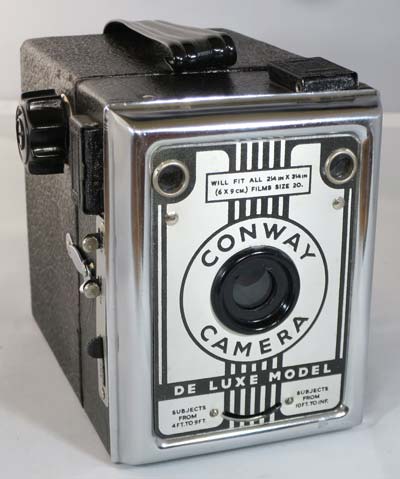Standard Conway De Luxe
Specification

| Manufacturer | : | Standard Cameras Limited |
|---|---|---|
| Produced | : | 1952 |
| Classification | : | Medium Format |
| Body Type | : | Box |
| Construction | : | Cardboard/Wood/Metal |
| Film Type | : | 120 |
| Film Width | : | 62mm |
| Image Size | : | 2¼ x 3¼ in |
| No. of Images | : | 8 |
| Lens Type | : | Meniscus |
| Focal Length | : | 115mm |
| Focus Type | : | Variable |
| Focus Range | : | 10ft to inf. (4-9ft with close-up lens) |
| Aperture Type | : | Fixed |
| Aperture | : | f/14 |
| Shutter Type | : | Rotary |
| Shutter Speeds | : | B, I*(1/35 sec) |
| Extras | : | Green Filter |
| Size (w x h x d) | : | 95 x 110 x 130 mm |
| Weight | : | 467g |
| * Measured on this camera | ||
Art Deco Credentials
![]()
![]()
Acceptable: Modest and restricted
- Produced after the main Art Deco period;
- Art Deco pattern on front plate;
- Chrome surround to front plate;
- Chrome body latches.
Description
The Conway De Luxe camera was manufactured by the Standard Camera Ltd. company of Birmingham, England in 1952. It is a simple box camera designed to capture 6 x 9 cm exposures on 120 roll film. It's body is constructed from card on a Bakelite frame with a metal film transport system. It has a very decorative metal front plate mounted on a chrome surround. It has two brilliant finders for horizontal or vertical photos. The viewfinders are covered with hinged protectors. On the top, it has a ribbed plastic handle. It has no tripod mount.
The fixed focus meniscus lens covers distances from 10 ft. to infinity but a built in close-up lens can be swung into place for subjects between 4 to 9 ft (1-3 m). It only has a simple time and instantaneous exposure shutter. There is a built-in retractable green colour filter that can be slid into place. A green filter is mainly used for photographing plants as it helps separate the green foliage from the brightly-coloured flowers and buds. The film advance is not coupled to the shutter release so double exposure is possible. It has a red window to view frame numbers.
How to Use
This camera takes 120 film which is easily available.
As the shutter speed is only 1/30s, it is advisable to use a tripod to get hold it against a wall or other solid object to keep the camera steady. For quick snapshots, hold it firmly against your body.
If you don't want to bother with an exposure meter, follow the guide shown. It is based on the 'Sunny 16' rule. Film is so forgiving and will produce acceptable results even when overexposed by 2 or 3 stops or underexposed by 1 stop.
The tables assume that the sun is at least 30 degrees above the horizon - that's 10am - 5pm on a summers day (May - August) in the UK.
Remember that the exposure guide in the manual may not be helpful as it is based on the use of old film with a low ISO value.
Using ISO 100/125 film - shutter speed 1/30s
| Weather Conditions | Shadow Detail | Aperture | Exposure |
|---|---|---|---|
 Sunny SunnySnow/Sand | Dark with sharp edges | f/14 | +3 Stops Overexposed Acceptable |
 Sunny Sunny | Distinct | f/14 | +2 Stops Overexposed Acceptable |
 Slight Overcast Slight Overcast | Soft around edges | f/14 | +1 Stop Overexposed Acceptable |
 Overcast Overcast | Barely visible | f/14 | Good |
 Heavy Overcast Heavy Overcast | None | f/14 | -1 Stop Underexposed Acceptable |
 Open Shade Open Shade/Sunset | None | f/14 | -2 Stops Underexposed Not Acceptable |